Growing your own vegetables brings a unique sense of joy and accomplishment. Fresh, flavorful produce right from your backyard is not only satisfying but also promotes self-sufficiency. Whether you’re a seasoned gardener or a complete novice, this guide simplifies the process with easy-to-follow steps.
One of the best parts about creating a garden is its accessibility. You don’t need a large space or expensive tools. A small raised bed or even containers can yield impressive results. Imagine harvesting tomatoes that cost pennies to grow but taste like a million bucks.
Beyond the cost savings, gardening offers environmental and health benefits. Reducing food miles and enjoying pesticide-free veggies are just a few perks. This guide focuses on raised beds, beginner-friendly plants like lettuce, and seasonal planning to ensure success.
Key Takeaways
- Growing vegetables at home is rewarding and promotes self-sufficiency.
- Beginner-friendly methods make gardening accessible to everyone.
- Raised beds and containers are great for small spaces.
- Gardening saves money and reduces environmental impact.
- Easy-to-grow plants like tomatoes and lettuce are perfect for beginners.
Why Start a Veggie Garden?
There’s something magical about plucking fresh veggies from your own backyard. Homegrown produce offers unmatched flavor and freshness. For example, garden lettuce tastes crisper and sweeter than store-bought varieties. It’s a simple pleasure that transforms meals.
Growing your own food also saves money. A single tomato plant costs $3-$5 but can yield up to 10 pounds of tomatoes. Herbs like basil or cilantro are another great example. A $5 plant can replace countless $3 grocery packets over the year.
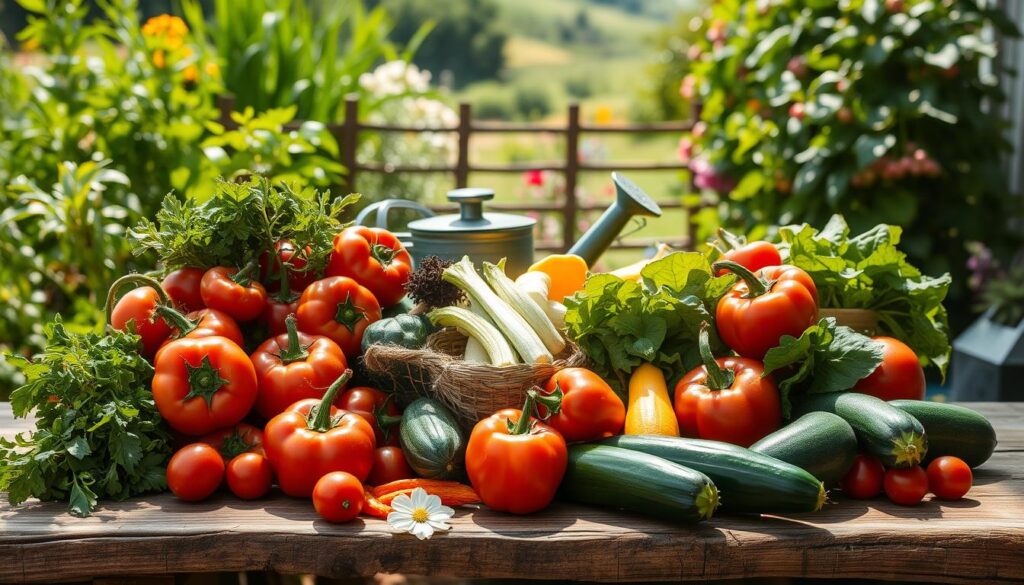
Gardening isn’t just about saving money. It’s a form of exercise that reduces stress. Spending time outdoors, nurturing plants, and connecting with nature can improve mental health. It’s a peaceful escape from daily routines.
Another benefit is sustainability. Growing seasonal food reduces reliance on imported produce. It cuts down on transportation emissions and supports local ecosystems. For beginners, crops like zucchini or peppers are easy to grow and highly rewarding.
Ready to dive in? Check out this beginner-friendly guide for more tips. Whether you’re growing herbs or tomatoes, your garden will bring joy and fresh flavors to your table.
Choosing the Right Location for Your Garden
Picking the perfect spot for your garden sets the stage for a thriving harvest. The location you choose impacts everything from plant growth to ease of maintenance. A well-planned garden bed ensures your veggies get the resources they need to flourish.

Sunlight Requirements
Most vegetables thrive with 6-8 hours of direct sunlight daily. To track sunlight patterns, observe your yard throughout the day. Notice where shadows fall and how they shift. This helps identify the sunniest spots for your garden bed.
If your yard has limited sun, don’t worry. Plants like lettuce and kale tolerate partial shade. These are great options for less sunny areas. Just ensure they still receive at least 4 hours of sunlight for healthy growth.
Soil Drainage and Quality
Healthy soil is the foundation of a successful garden. Test your soil’s texture with a simple squeeze test. Gritty soil is sandy and drains too fast. Sticky soil is clay-heavy and retains too much water. Aim for a balance that holds moisture without becoming waterlogged.
If drainage is poor, consider raised beds. They prevent root rot by allowing excess water to escape. Adding compost improves soil structure, making it ideal for plant roots. These steps ensure your garden bed provides the best environment for growth.
Lastly, protect your plants from strong winds. Avoid open, windy areas that can damage seedlings. A sheltered spot ensures your garden thrives from the very beginning.
How to Start a Veggie Garden: Step-by-Step
For beginners, taking small steps ensures a rewarding gardening experience. A well-planned garden bed is the key to success. Whether you choose an in-ground plot or raised beds, starting small helps you manage your time and resources effectively.
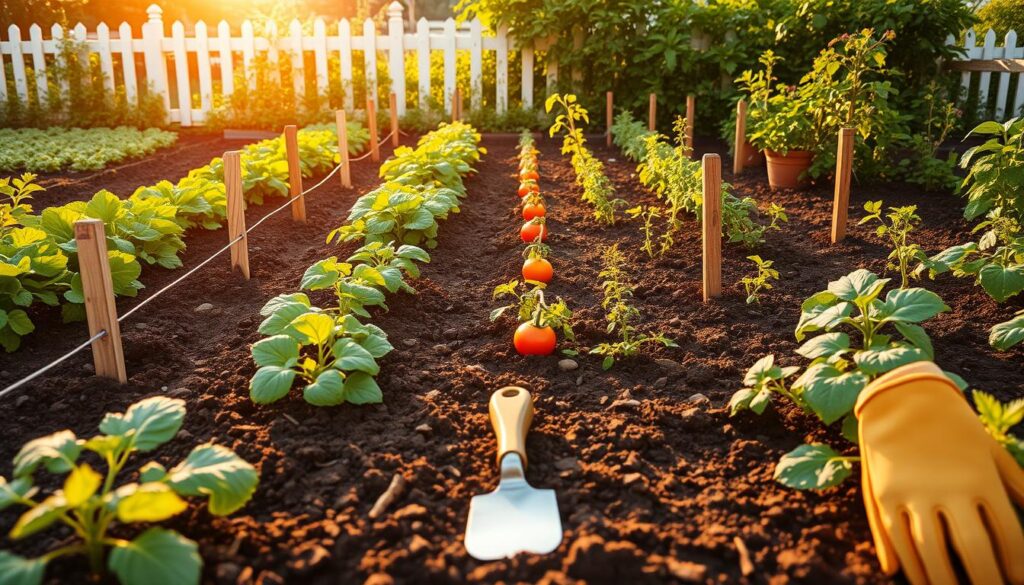
Begin with a manageable size, like a 6×6 ft in-ground plot or a 4×4 ft raised bed. This allows you to focus on a few plants without feeling overwhelmed. Use tools like the Old Farmer’s Almanac Garden Planner to plan spacing and crop rotation for optimal growth.
Here’s a simple step-by-step guide to get you started:
| Step | Action | Tips |
|---|---|---|
| 1 | Choose a small, manageable size | 6×6 ft in-ground or 4×4 ft raised bed |
| 2 | Smother grass/weeds | Use cardboard for the permaculture “lasagne method” |
| 3 | Layer soil with compost | Add manure for nutrient-rich beds |
| 4 | Select beginner-friendly seedlings | Choose bok choy or kale over seeds |
| 5 | Water with seaweed fertilizer | Use products like Seasol to reduce transplant shock |
Starting with raised beds is a great option for beginners. They improve drainage and make it easier to control soil quality. Layering compost and manure ensures your plants have the nutrients they need to thrive.
Selecting beginner-friendly seedlings, like bok choy or kale, increases your chances of success. These plants are hardy and require minimal maintenance. Watering with seaweed fertilizer helps reduce transplant shock and promotes healthy growth.
By following these steps, you’ll set up a garden bed that’s ready to produce fresh, delicious vegetables. Remember, starting small and focusing on the basics will make your gardening journey enjoyable and stress-free.
Selecting the Best Vegetables for Beginners
Choosing the right vegetables can make your gardening journey smooth and enjoyable. Beginners should focus on plants that are hardy, fast-growing, and low-maintenance. These varieties ensure success and keep your motivation high.
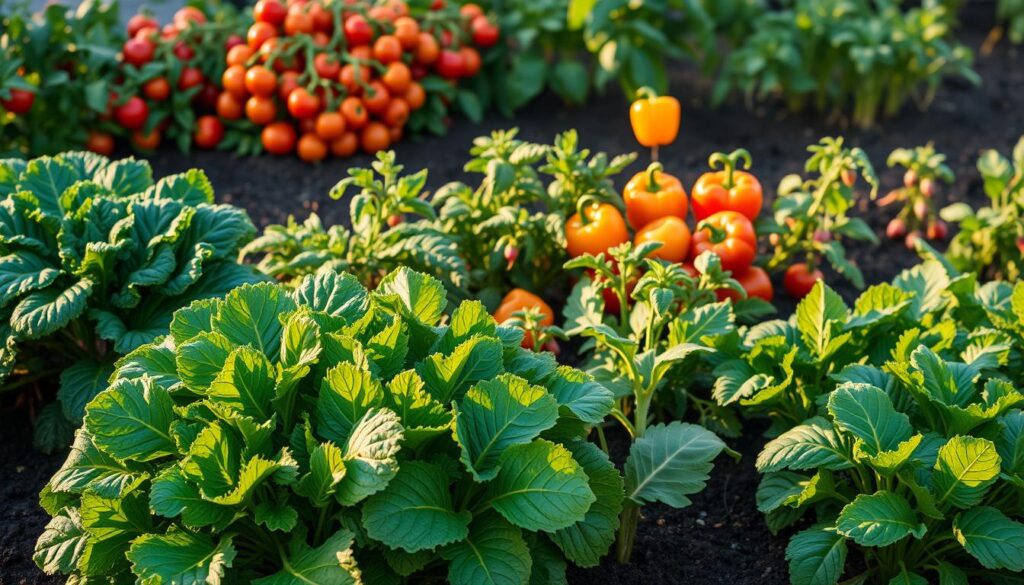
Easy-to-Grow Vegetables
Some plants are perfect for first-time gardeners. Lettuce is a top choice because it grows quickly and thrives in cool weather. Green beans are another excellent option, producing abundant harvests with minimal care.
Radishes mature in just 3-4 weeks, making them a rewarding pick for beginners. Zucchini and peppers are also great, as they grow well in warm conditions and yield plenty of produce. These plants are forgiving and ideal for learning the basics.
Seasonal Planting Tips
Understanding the right season for each crop is crucial. Cool-season plants like peas, carrots, and broccoli thrive in early spring or fall. Warm-season favorites, such as tomatoes and cucumbers, should be planted after the last frost.
Staggered planting ensures a continuous harvest. For example, sow lettuce every two weeks for a steady supply. Regional advice is also important—contact your local Cooperative Extension for climate-specific tips.
Avoid planting out of season. For instance, tomatoes won’t survive winter frosts. Companion planting, like adding marigolds, can deter pests naturally and boost your garden’s health.
Preparing Your Garden Bed
Setting up your garden bed is the foundation for a thriving harvest. Whether you choose raised beds or in-ground plots, proper preparation ensures your plants grow strong and healthy. The right approach depends on your space, budget, and gardening goals.
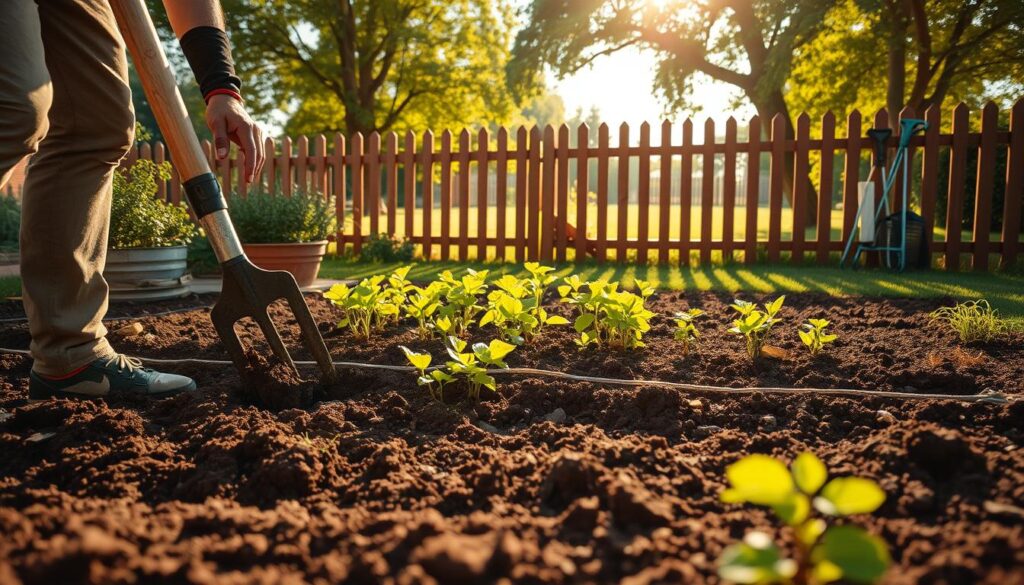
Raised Beds vs. In-Ground Gardens
Raised beds are a popular choice for many gardeners. They improve drainage, reduce back strain, and offer better control over soil quality. While the upfront cost is higher, the long-term benefits make them worth considering.
In-ground gardens are more affordable but require more effort to maintain. They’re ideal for larger spaces and can be enhanced with proper soil amendments. Both options have their pros and cons, so choose based on your needs.
Soil Preparation Techniques
Healthy roots start with healthy soil. One effective method is lasagne gardening. Layer cardboard, compost, manure, and straw to create nutrient-rich beds. This approach suppresses weeds and improves soil structure over time.
For a 4×4 ft raised bed, use 8 cubic feet of soil. Mix 4 bags of compost with 4 bags of manure for optimal fertility. The no-dig method is another great option. It preserves soil health by avoiding weed disruption and maintaining natural layers.
Test your soil’s pH and aim for 5-10% organic matter. Modular beds, like Birdies Heritage, are perfect for easy expansion. With the right preparation, your garden bed will provide the perfect environment for your plants to thrive.
Planting Your Vegetables
The moment you place a seed or seedling into the soil, you’re setting the stage for growth. Whether you’re working with seeds or transplants, proper techniques ensure your garden thrives. This section covers the essentials of planting, from choosing between seeds and seedlings to arranging your plants for optimal growth.
Starting from Seeds vs. Seedlings
Deciding between seeds and seedlings depends on your experience and goals. Seedlings, like nursery-grown tomato plants, reduce the risk of failure for beginners. They’re already established, giving you a head start. Seeds, on the other hand, are more cost-effective but require patience and care.
For example, tomatoes often thrive as transplants. Starting from seeds can be tricky due to their sensitivity to temperature and moisture. If you’re new to gardening, investing in seedlings is a smart choice. They’re hardy and ready to grow, increasing your chances of success.

Proper Spacing and Arrangement
Proper spacing ensures your plants have room to grow and access to resources. Follow the guidelines on seed packets or plant tags. For instance, bush beans need about 6 inches between each plant, while zucchini requires 3 feet of space.
Square-foot gardening is a great method for small areas. You can grow 9 spinach plants per square foot, maximizing your space. Vertical trellises are another smart solution. They save ground space and support climbing plants like peas and cucumbers.
Arrange taller plants, such as corn or pole beans, on the north side of your garden. This prevents them from shading smaller plants. Avoid overcrowding, as it can lead to diseases like powdery mildew. With thoughtful arrangement, your garden will flourish.
Watering and Maintenance Tips
Proper care ensures your garden thrives, producing fresh, healthy vegetables. Consistent watering and effective weed and pest control are essential for success. These practices not only keep your plants healthy but also save you time and effort in the long run.

How Often to Water
Deep watering 2-3 times a week is better than light daily sprinkles. This encourages roots to grow deeper, making plants more resilient. Use the “finger test” to check soil moisture—if it’s dry 2 inches down, it’s time to water.
Soaker hoses or drip irrigation systems are efficient options. They deliver water directly to the roots, reducing evaporation and waste. Mulching with straw helps retain moisture and suppress weeds, keeping your garden bed healthy.
Weed and Pest Control
Weeds compete with your plants for nutrients and sunlight. Regularly removing them ensures your vegetables get the resources they need. Tools like a collinear hoe make weeding faster and easier.
For pests, handpick caterpillars and use insecticidal soap for aphids. Organic solutions like neem oil are effective against common pests like cabbage moths. Crop rotation also helps prevent soil-borne diseases, keeping your garden thriving.
| Watering Method | Benefits | Tips |
|---|---|---|
| Soaker Hoses | Efficient, reduces evaporation | Place hoses near plant roots |
| Drip Irrigation | Precise, minimizes waste | Use a timer for consistency |
| Hand Watering | Direct control | Water early morning or late evening |
Harvesting Your Vegetables
Harvesting your vegetables is the most rewarding part of gardening. The moment you pick your first ripe tomato or crisp lettuce leaf, all your hard work feels worth it. Knowing when and how to harvest ensures your produce tastes its best and lasts longer.
Leafy greens like kale and lettuce are “cut-and-come-again” crops. This means you can harvest the outer leaves while the plant continues to grow. For tomatoes, wait until they’re firm and fully colored. Zucchini is best picked when it’s 6-8 inches long for the best flavor and texture.
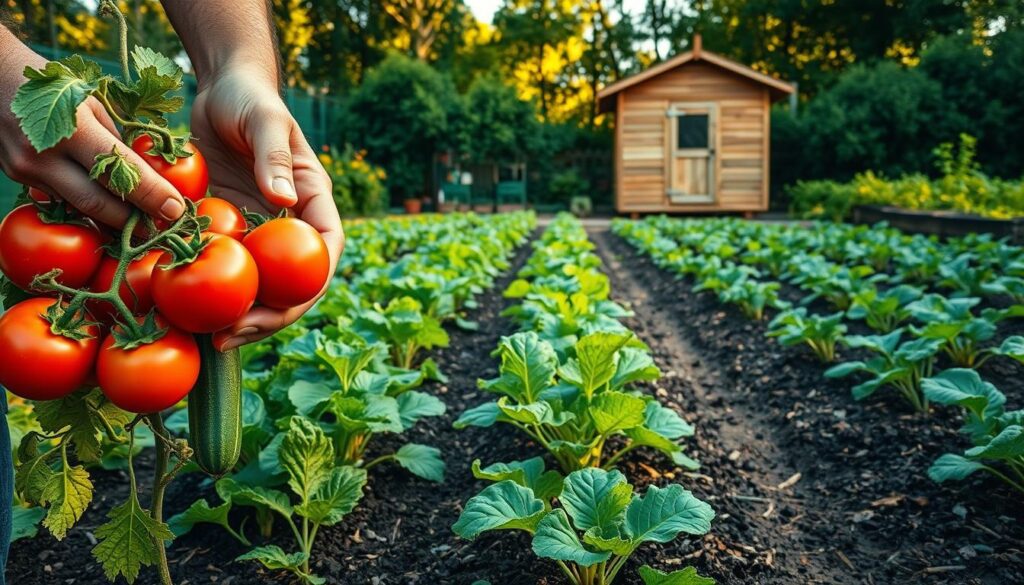
Timing is key for peak flavor. Morning is the best time to harvest, as plants are hydrated and sugars are concentrated. For example, peas taste sweeter when picked early in the day. Herbs like basil and cilantro are also more flavorful in the morning.
Preserving your harvest ensures you enjoy your garden bounty all year. Freeze excess produce like beans or peppers. Canning is great for tomatoes and pickles. Herbs can be dried or turned into pesto for long-term storage.
Succession planting keeps your garden productive. After harvesting summer crops like beans, plant fall favorites like spinach or carrots. This maximizes your season and ensures a continuous supply of fresh vegetables.
| Vegetable | Signs of Ripeness | Best Harvest Time |
|---|---|---|
| Tomatoes | Firm, fully colored | Morning |
| Zucchini | 6-8 inches long | Early morning |
| Peas | Plump pods | Morning |
| Lettuce | Outer leaves 4-6 inches | Cool morning |
With these tips, you’ll enjoy the freshest, most flavorful produce from your garden. Whether you’re roasting root vegetables or making a salad, your harvest will bring joy to every meal.
Conclusion
Embracing the journey of growing your own food is both fulfilling and simple. Starting small with a raised bed or a few containers makes it accessible for any beginner. Watching your plants thrive brings a sense of accomplishment and joy.
As you gain confidence, expand gradually. Add one new vegetable each season to keep your garden exciting and manageable. Share your harvest with neighbors or donate excess produce to local food banks. It’s a wonderful way to give back to your community.
For more guidance, explore resources like the Almanac Garden Planner. It’s a helpful tool for planning and tracking your progress. Remember, your first tomato sandwich is just a seed away!

